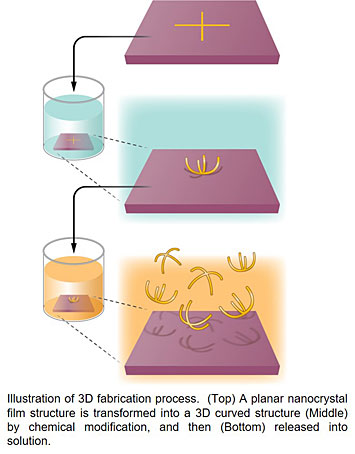3D Nanofabrication of Cell-Sized Machines
September 28, 2018
What is the scientific achievement?
CFN users from the University of Pennsylvania have developed a new method for fabricating 3D cell-sized machines from colloidal nanocrystal films. Manipulating the organic ligands that cap the nanocrystals in a thin film introduces controlled strain, which causes fabricated structures to “fold-up” into 3D configurations.
Why does this achievement matter?
This strategy may be used to fabricate 3D, cell-sized machines with unique integrated optical and magnetic properties derived from the nanocrystal constituents. Potential examples are helical structures for plasmonic metasurfaces and claw-shaped structures for capturing tumor cells and bacteria.
What are the details?
Planar nanocrystal/bulk hetero-structures are transformed into three-dimensional architectures by taking advantage of the different chemical and mechanical properties of nanocrystal and bulk thin films. Nanocrystal/bulk hetero-structures are fabricated via bottom-up assembly and top-down fabrication. Nanocrystals are capped by long ligands introduced in their synthesis, and therefore their surfaces are chemically addressable, and their assemblies are mechanically “soft,” in contrast to bulk films. Chemical modification of the nanocrystal surface, exchanging the long ligands for more compact chemistries, triggers a large volume shrinkage of the nanocrystal layer and drives bending of the nanocrystal/bulk hetero-structures. Exploiting the differential chemo-mechanical properties of nanocrystal and bulk materials, the scalable fabrication of designed three-dimensional, cell-sized nanocrystal/bulk superstructures are demonstrated, which possess unique functions derived from nanocrystal building blocks.
CFN Capabilities:
The CFN Nanofabrication Facility was used to fabricate cm-scale stamps for nanoimprinting using e-beam lithography.
Publication Reference
Mingliang Zhang, Jiacen Guo, Yao Yu, Yaoting Wu, Hongseok Yun, Davit Jishkariani, Wenxiang Chen, Nicholas J. Greybush, Christian Kübel, Aaron Stein, Christopher B. Murray, and Cherie R. Kagan, Three-dimensional Nanofabrication via Chemo-mechanical Transformation of Nanocrystal/Bulk Hetero-structures, Adv. Mater. 30, 1800233 (2018).
Acknowledgement of Support
The authors are grateful for primary support of this work from the National Science Foundation (NSF) under Award No. CMMI-1562884 for hetero-structure fabrication and characterization. Synthesis of Au nanocrystals was supported by National Science Foundation Grant No. NSF-561658, and synthesis of magnetic nanocrystals was supported by the Catalysis Center for Energy Innovation, an Energy Frontier Research Center funded by the U.S. Department of Energy, Office of Basic Energy Sciences under Award no. DE-SC0001004. E-beam lithography to pattern the nanoimprint lithography master stamp was carried out at the Center for Functional Nanomaterials, Brookhaven National Laboratory, which is supported by the U.S. Department of Energy, Office of Basic Energy Sciences, under Contract No. DE-AC02-98CH10886. Electron tomography was performed at Karlsruhe Nano Micro Facility (KNMF), Karlsruhe Institute of Technology (KIT). MZ is grateful for support from the NatureNet Science Fellowship offered by the Nature Conservancy. JG was supported by Chinese Scholarship Counsel (CSC). YY was supported by Penn’s Department of Materials Science and Engineering Masters Scholars Award. Scanning electron microscopy/FIB was performed in facilities supported by the NSF MRSEC Program under Award No. DMR-1720530
2018-14305 | INT/EXT | Newsroom










